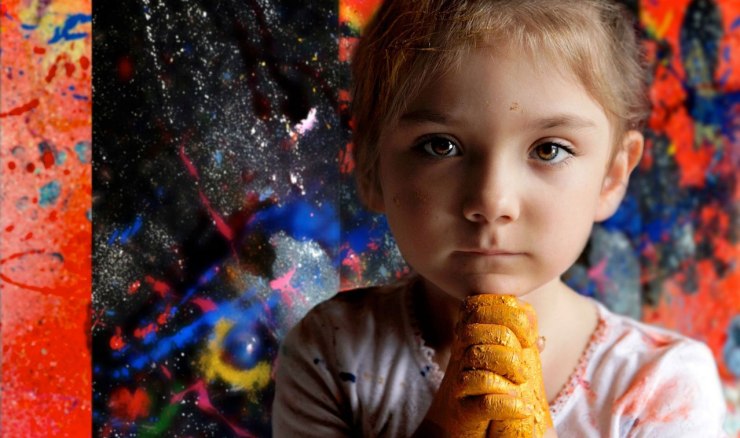
Have you heard of the child art prodigy, Aelita Andre? I just heard of her today from a short news clip. Apparently she’s quite famous, has had a one person show in New York City, and sold one work for $50,000. Before I saw the paintings of the 7 year old (who has been in the international spotlight since she was 4), I thought they were going to be crude, and the beauty would be in the eye of the believer. What surprised me, once I saw a few, was that the child had a very good eye for selecting and combining color, and her style didn’t look like precocious child’s art, but rather like rather good, and highly slick (if craftsy) art by an adult familiar with the history of abstract painting, as well as the techniques and tools of the trade. Is she the art wunderkind of an era, or is the art world just rationally untethered and gullible?
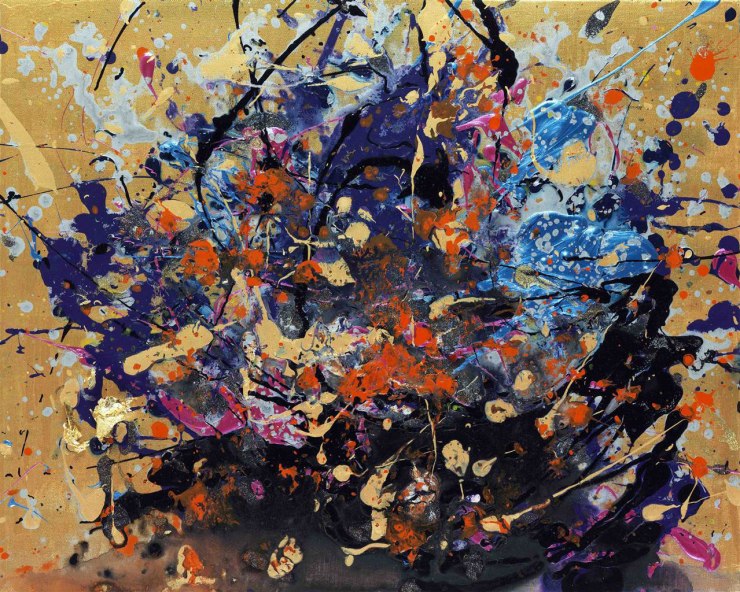
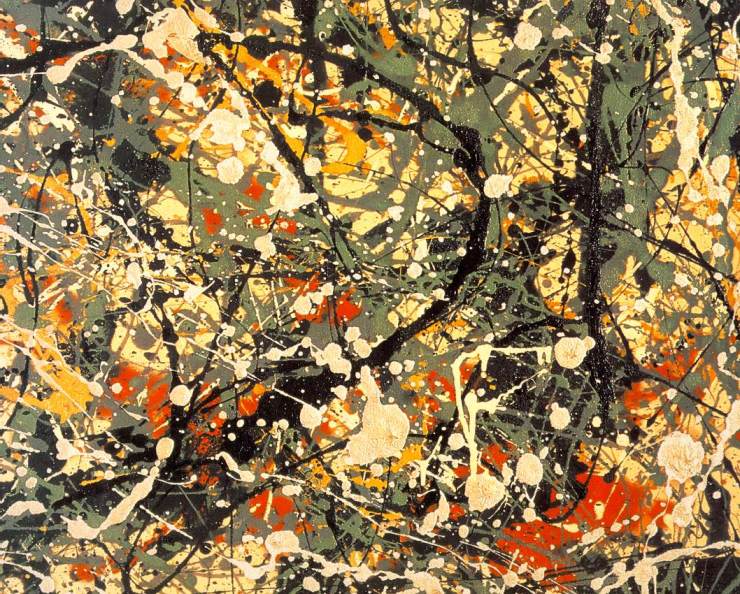
I stop and wonder if her painting would even be possible without Jackson Pollock. While “Autumn Rain” vividly shows the child artist’s skills, it also challenges the grandiosity of Modernist masterworks we’ve admired for decades, and which sell for tens of millions of dollars. Or so it would seem at first. Someone had to be an admirer of the art of Pollock for “Autumn Rain” to exist, and ultimately what we are seeing is that person’s handiwork. But that person is not the seven year old, Aelita Andre.
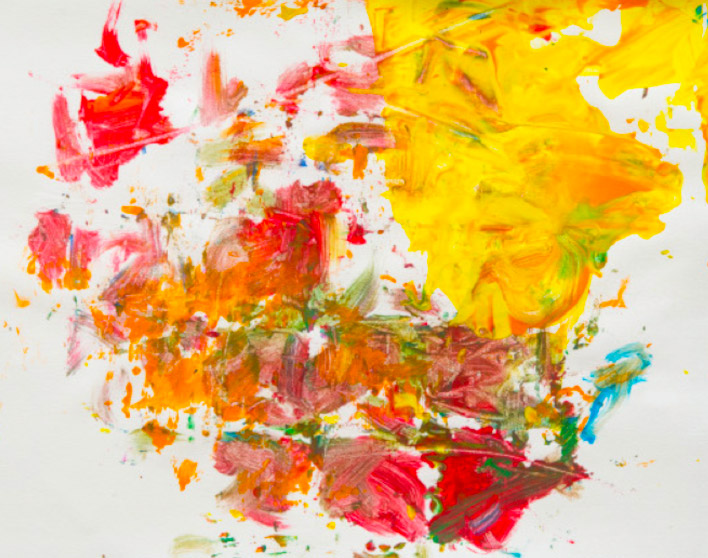
It didn’t take much research to crack this case. According to a Wikipedia article:
Aelita Andre was born to Australian father Michael Andre and Russian mother Nikka Kalashnikova.[1] As a baby, she often watched her parents, both artists themselves, work on canvases on the floor.
This is extremely telling. I tried to find out what the parent’s artwork looked like, but Google searches turned up nothing. My guess is that it looks a lot like Aelita’s. I’m not saying that the parents are painting her canvases themselves – there are videos of Aelita splashing on paint and even priming the background of the canvases with color – but that the parents set up the parameters in which the child operates, and they taught her how to make drip/splash paintings. Let me put it this way: the parents have a formula, or make a template, in which the child can hardly go wrong.
There’s a big difference between a child finding some house paint and butcher paper and spontaneously making Pollock-esque paintings, and a child being given a canvas on the floor and the ideal paints and tools, by her parents, to work with in a tradition with which they are intimately familiar. Similar things have been done with chimpanzees.
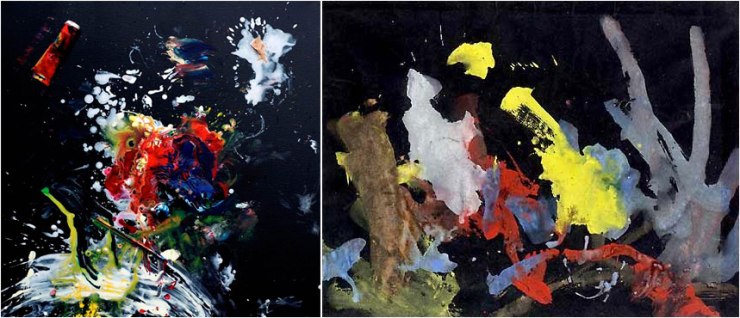
The more I look at Aelita’s paintings the more they look like the expertly packaged and slick craft of art-savvy adults.
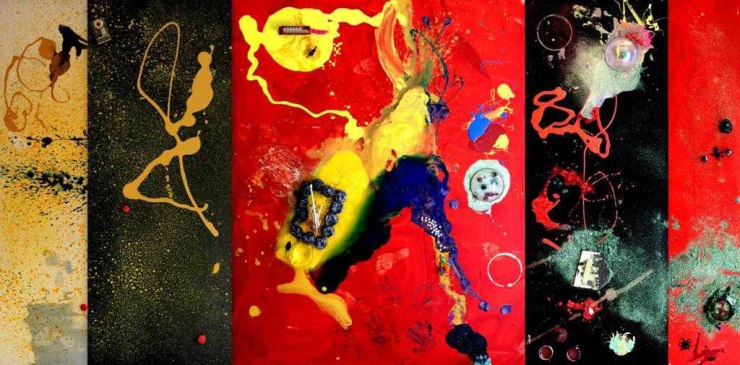
The painting above is constructed of five, five foot tall custom ordered canvases, and is over ten feet wide. That part had to be the parent’s plan, as did the forethought to prime the canvases. What’s left over that the child did is not as spectacular as the pre-packaging. What we see are various splashes and splatters, all in accordance with an adult’s carefully manipulated framework.
Below is the same painting as above, but I’ve cut and repositioned the panels to show that it doesn’t really make a difference where they go, or which way the paint was flung, and there’s a hell of a lot of leeway for mistakes. The “container” that the parents set up, works probably with whatever the child slops on top of it.
The success of the resulting canvases is due to the initial preparation, or set up, done by the parents, for the child to work within. My guess is the parents carefully choose the color palette as well. What is left for the child to do is the more random component required to complete the preconceived work. The parents might be able to do it themselves, especially after too much to drink, blindfolding themselves, or spinning around until they are dizzy before slinging the pigment. Specificity is not required: a looseness and spontaneity is.
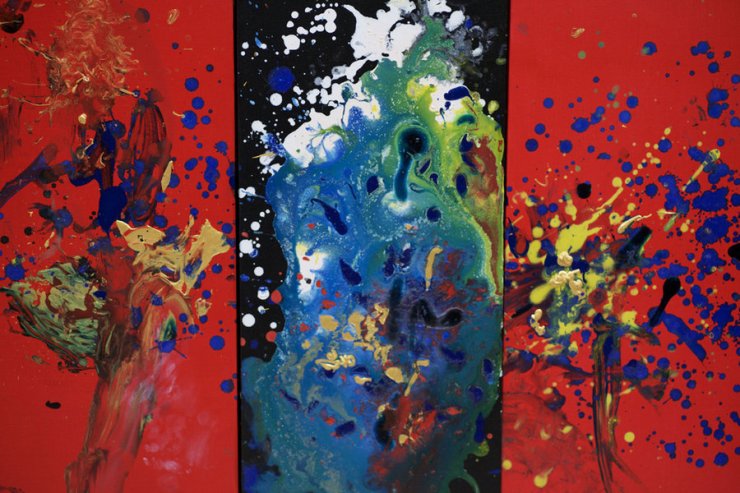
It may be that the child has a good eye, but I doubt that there aren’t thousands of other children in any large city that could do the same under the same truly exceptional conditions, just like many chimpanzees, given the right brushes, colors, and tutelage, could crank out art that looks like the Abstract Expressionist paintings their trainer is probably unintentionally guiding them to mimic.

This also reminds me of Damien Hirst training kids to make his spin paintings at an event he hosted for a charity. Each of these children becomes an instant child art prodigy once everything is set up for them to add the loose, unpremeditated part, which has already been meticulously planned for.
This story is deja vu if you know about another art prodigy of about ten years ago, one Marla Olmstead. She was also considered an Abstract Artist childhood phenomenon, until her parents agreed to allow a CBS film crew to set up a hidden camera in her home to document her painting process over the span of a month. After reviewing the footage, a child psychologist observed, “I saw no evidence that she was a child prodigy in painting. I saw a normal, charming, adorable child painting the way preschool children paint, except that she had a coach who kept her going.”

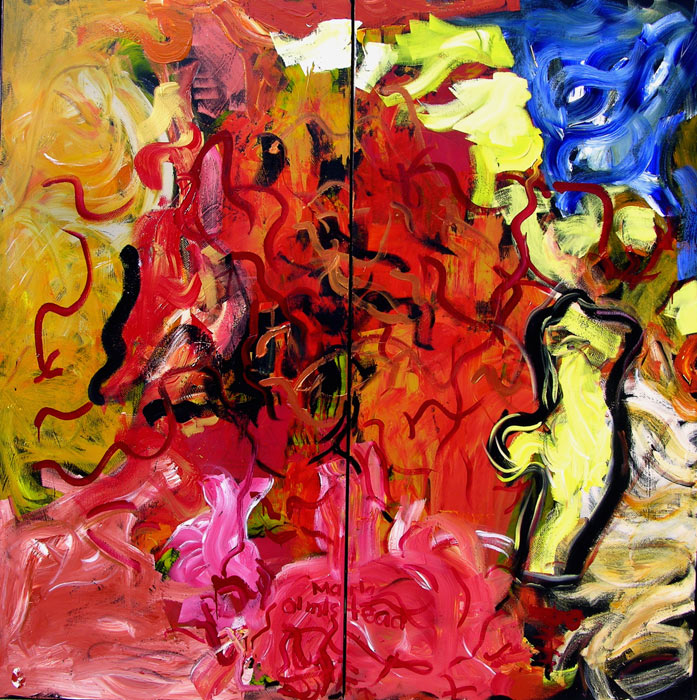
At the end of the coffee break (it didn’t take me a whole day, or even ten minutes to figure this out), the art being sold as that of a child art prodigy is actually the vision of one or both of her parents, and merely executed by the child. At most the work could be called a collaboration in which the child played a minor role, which could be performed as well by other children with a bit of training. In a word, it’s a “gimmick”.
And there’s another big reason people are being chumped: they don’t understand that a splatter painting made in 2014 isn’t as innovative as Jackson Pollock’s drip paintings starting more than 60 years ago. Without realizing the role of the Neo Abstract Expressionist parents, who painted on the floor, they assume the child made the same imaginatory leap as the pioneer Abstract Expressionists of mid last century, and further credit her with intuitively understanding all art which preceded that stage, before she triumphantly eclipsed it. In reality she has nothing to do with Pollock, and no real understanding of art history. She acts as a child imitating what her parents do and encourage, at a time in her life where she isn’t even capable of questioning their authority. This isn’t a mature, sophisticated mind, dealing with issues of how society visually interprets and represents reality, and developing that, as the Abstract Expressionists did: it’s a mind in the early stages of development playing at arts and crafts in accordance with an already hackneyed art paradigm advocated by her own parents.
Stop and think how convenient it is that she does drip paintings. So hard to tell if that splatter is genius or accident. If we really want to see if Aelita is the golden child of art, let’s have a look at her drawings. Most any other kid who is good at art at a young age will like to draw, so, we’d expect that someone with gifts to outshine Picasso would probably take up a pencil, pen, or crayon, and produce something not only remarkable, but unexpected. It simply can’t be that when her classmates are drawing, and showing off their creations, she shrugs it all off and doesn’t feel the need to test her hand. And yet there are no drawings to be seen. What if she’s given paper and some colored pastels, and produces exactly the same sort of drawing any other 7 year old would produce, and not even an especially good one? Then the game would be up.
Drawing would level the playing field and produce a more controlled experiment. The prodigy’s drawings would have to be exceptional relative to that of other kids for us to worship her as some sort of special being with capacities the rest of us mortals do not possess. Since most kids have access to drawing materials, Aelita would lose her advantage, even if her parents coached her.
The only normal art a child would do we’ve seen from her (that I’m aware of), is a tinfoil unicorn.

In a promotional film for Aelita’s art, she is seen making a sculpture of a unicorn out of aluminum foil. The segment is gorgeously filmed, with scarlet reflections making the otherwise drab foil look magical. But presentation aside – and the overwhelming likelihood that the parents coached her, such as by first making an armature to wrap the foil around – the resulting unicorn is unexceptional. That is, until filmed with dramatic spot lighting that highlights every fold and wrinkle and makes it look like it’s elaborately chiseled and cast in iron.

Even with the most polished packaging possible, the child’s sculpture is a UNICORN. It’s a whopping cliche, and a typical child’s art. Nothing to see here, folks, keep moving, don’t block the road. Imagine it as a drawing, and it is unexceptional for a child of her age.
For my tastes, the parents went too far with the “sound paintings”. Here violins are affixed to canvases, and once the splashing of paint is complete, the artist can run a bow across the painted violins to make “sound paintings”. It’s all too obviously “orchestrated”, and the greater the lengths the parents go to supersize their daughter’s art, the less it showcases whatever talent she might have in lieu of demonstrating their own marketing ingenuity. Stop and think about it: what seven year old has the wherewithal to buy new violins to place on canvas panels to paint over?

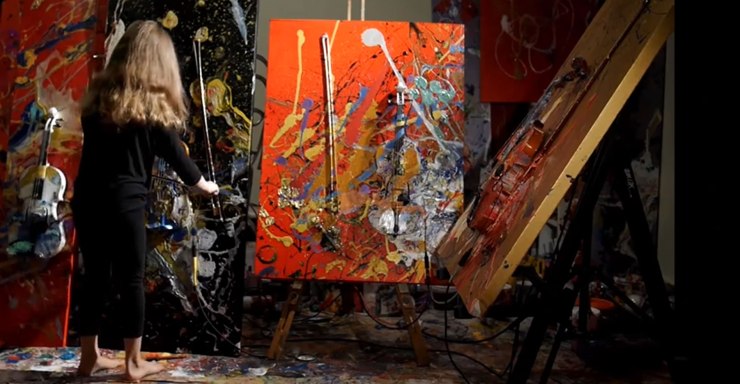
I see this as a conceptual art project by the parents, and staring their child, which is why it all looks like the work of middle-aged artists well familiar with the craftier side of the art world and art market. The pieces are only truly impressive because they are ostensibly done by a child. The enterprise in its entirety is heavily influenced by the model carved out by the Olmsteads, and starring Marla Olmstead. Who will be the next art prodigy? Parent’s, get to work on your art-style formulas, gimmicks, background stories, and marketing strategies.
Call me cynical, or just an animal lover, but I prefer chimp art to precocious little blonde girl art. Somebody give a chimp the chance to splash colors over, say, a triptych with electric guitars mounted on each panel. THAT I want to see! Note that the chimp below is not only a chimp, but she’s also only three, so a “chimpanzee prodigy”.
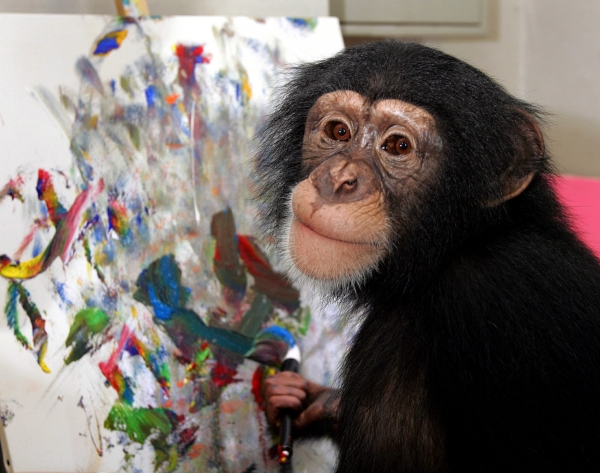
Aelita may be a wunderkind of art, if there is such a thing, but I for one won’t be able to tell until she does something far less scripted. I’m also not a believer in people being born genius artists, but rather see the great artists as normal people who did a lot of hard work. And some people like to believe there are those of us who are different and special, like royalty, but I think we are all special and nobody is really different. For now the best I can tell about Aelita is that she’s pretty damned good at splashing paint, having grown up doing so, whereas other kids her age are pretty damned good at drawing dinosaurs (a skill which she curiously does not exhibit). They just have different parents, grew up in different environments, and learned different visual art skills. I don’t expect any controlled experiments, but I predict that the parents’ teaching method and materials could be used to teach whole classrooms full of students to do art like Aelita, just as the kids below are creating similar pieces in a Country Fair in Japan.
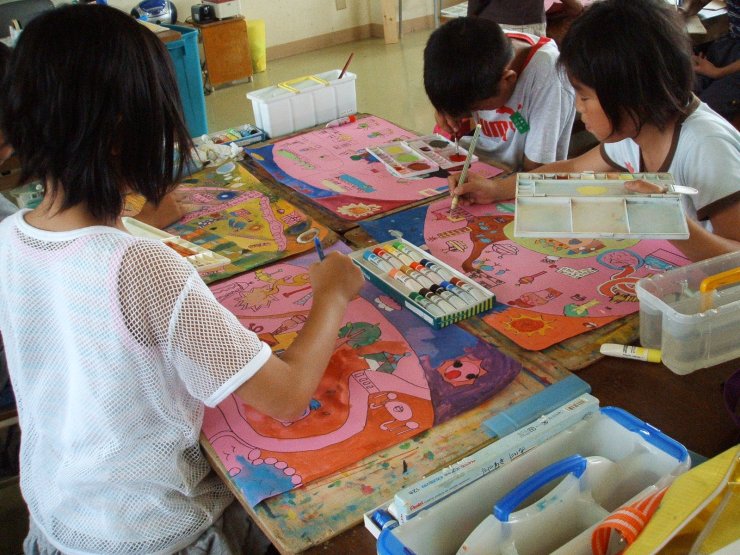 The sad thing is that so many adults and critics seem to believe that her paintings are on par with the work of Pollock or de Kooning, when sometimes her creations are ghastly, and if they work it seems to be because of happy accidents inherent to the process itself. But, then again, the great achievements of the legends of high Modernist art, and those of the genius wunderkind, probably both deserve to be taken down a notch. But just to be clear, we are not comparing the masterpieces of Pollock or de Kooning to a child’s art, but rather to the sophisticated productions of two adult Abstract Expressionist painters (at least at one point, though now it seems one of them does photography and the other film), and one child. At first blush the family’s creations are more brightly colored and have a superficial appeal, but the more time you spend with their images the more they fade as compared to the real works of the Abstract Expressionists of mid last century.
The sad thing is that so many adults and critics seem to believe that her paintings are on par with the work of Pollock or de Kooning, when sometimes her creations are ghastly, and if they work it seems to be because of happy accidents inherent to the process itself. But, then again, the great achievements of the legends of high Modernist art, and those of the genius wunderkind, probably both deserve to be taken down a notch. But just to be clear, we are not comparing the masterpieces of Pollock or de Kooning to a child’s art, but rather to the sophisticated productions of two adult Abstract Expressionist painters (at least at one point, though now it seems one of them does photography and the other film), and one child. At first blush the family’s creations are more brightly colored and have a superficial appeal, but the more time you spend with their images the more they fade as compared to the real works of the Abstract Expressionists of mid last century.
The Andre family’s art productions are a “craft” version of Abstract Expressionism that relies on props, pretty colors, and cheeseball techniques to make their work seem like there’s more to it, when its just so much empty facade and decoration. It relies entirely for it’s impact on the misperception of the result with the unassisted imagination of a child. In reality, it is the equivalent of the music of the Partridge Family, but attributed only to Tracy Partridge, the little girl who plays tamborine and percussion.


Update: I just discovered a video of Aelita painting. It’s so painful to watch I can’t even finish it. She’s just slopping around paint mindlessly. I admit to thinking that you’d have to be kinda’ stupid to buy her art. And the paintings are gaudy to the point of being nauseating. See for yourself.
And there’s also this video of her painting when she was two, where it is also obvious she’s not particularly deliberately painting, because she can’t control the tubes of paint she is using directly, and finally ends up just rubbing her hands in the paint like any other 2 year old might. Embarrassing.
~ Ends



I guess your idea that a child (or ape) can be a tool (and not a truly independent artist) in the creation of an artwork is spot on. Great post!
LikeLike
I wanted to be skeptical, but the Maria CBS situation cinched it for me. If she really is amazing and special, let’s be transparent in her process. Those violins looked awfully set up, too. But children are naturally artistic. It’s just too bad that other children don’t have the opportunity to have their abilities and affinities to shine forth – all those materials are expensive. And yes, her promotional video was over-the-top. It’s kind of classic “parents living vicariously through their child” situation. But if she’s the real deal, she’ll stand the test of time…I mean I can’t imagine gaining the height of my fame at 7yrs old. Let’s hope she doesn’t grow up too fast.
LikeLike
I’ve been thinking about why I bothered to write about this story. Part of it is the objectionable idea that artists are born, and that some people are just naturally superior to the rest of us. And the other problem is that her work is a gimmick that the art world falls for and people spend tens of thousands of dollars on. How can people be so gullible?
LikeLiked by 2 people
You should check out Gladwell’s Outliers: The story of success. He takes you behind the scenes of highly successful people from Canadian hockey players to the Beatles and explains how they got to be so good.
LikeLike
Hostile troll comment deleted by moderator.
LikeLiked by 1 person
Cheers.
LikeLike
We can be as critical as we can, but by the time she finishes high school she will own a nice little house or two. It’s all business and has nothing to do with real art.
LikeLike
I apologize in advance, especially if what I say here has already been stated, or indeed if what I say is irrelevant to the discussion, as I didn’t read the other replies, or even the blog, to tell the truth. But to me opinions on art are simply that : opinions, and as such they are not worth the breath it takes to make them. I love all art equally but for different reasons. There are people who work very hard and study the craft and produce magnificent work. But why would you do that for the accolades of being a superior artist or to stanch the flow of your perception of “bad art”. One should do it out of love for it and love only, even if you are the only one doing it, which, I guarendamntee ya will not be the case. There is ALL kinds of fantastic art going on that anyone has access to experience. But people judge everything on dollar value. Why should this little girl (or her guardians) make all kinds of money when there are the above mentioned “hard working” people unable to make a buck (which I guarendamntee ya never has to be the case) ? It’s because monetary economic systems are corrupt from the word go. Art is probably the least of its problems. People have to make a living in this world, true, however most are brainwashed into believing it can Only be done the conventional ways. So if the little girl wants to paint I say let her paint. And if the billionaires want to tell people she is genius to turn her work into a high priced commodity, well, it’s what they do.
LikeLike
She is just a product spawned by time we’re in. And also I don’t think that little girl paints while thinking oh this one’s going to be 3,000$ like I did. Prices are determined by her sales staffs. Sure there might be her parents who’re the brains of the business side but those paintings are her creations and we need to accept that fact. Price is judged by combination of presentations, the hype, her persona, the publicity and most of all, her paintings judged directly by each individual consumers who bought her work with their money. Rich people don’t buy art for the investments. They collect for the love and passion. That’s what poor people do collecting Beanie Babies hoping to get rich. If every rich people bought paintings for the investments, the market would crash and burn just like anything else related to collecting. There was a huge demand for a child prodigy for many decades and there she was on YouTube collecting fans for past years over many others. Rich people didn’t decide who is the winner here. That’s a conspiracy theory. We all decided she won.
LikeLike
“those paintings are her creations and we need to accept that fact.”
Are you aware that BOTH her parents were abstract painters who worked on the floor. Can you really say her creations are her own when she works in THAT same style. Why doesn’t she work in some other style? And isn’t it odd for a child to make 10 foot wide Abstract Expressionist paintings for galleries? In reality, we need to accept that they are her parents’ vision and practice. Otherwise she would have her own style, or would make drawings.
“Rich people don’t buy art for the investments.” Actually, it’s been shown that many of the most expensive art aquisitions were made by businessmen in tax evastion schemes and other dodgie business practices.
LikeLike
I think that whole thing was Psy Op. Xie tells his rich friend to buy the thing and next is him getting on the TV calling it money laundering so they can shutdown the anonymous bidding practices together. And if I was your art director, I would’ve told you the same. Consistency, consistency. Even I can look at some of lesser known unusual Jackson Pollock and think… hmm. Maybe he was overrated. I believe Aelita fully understood art before her style was developed. People who don’t understand art can certainly understand styles. They can never execute their styles without understanding art first.
LikeLike
“I believe Aelita fully understood art before her style was developed. ”
Do you think she also fully understood human nature, reality, and the cosmos? Do you think understanding art “fully” doesn’t require any knowledge of the world or of people? Do you think she could have written novels that rivaled Tolstoy is only she’d turned her talent to literature instead of visual art?
You do realize she started painting on the floor at age 2, at which point, according to you, she must have had a greater handle on art, life, and reality than you do at present.
As I argued in my post, I’d bet at least 25% of all children, given the same training, materials, and aid of her parents (both who worked in a similar style to hers) could achieve similar results, and some could do better.
This “childhood prodigy” stuff is on a par with royalty and celebrity worship. The best prodigys only showed enormous technical skill for their age, and this acquired through rigorous training, often by an overbearing parent. Children are capable of great strides in learning, which is evidence by their ability to pick up language in a fraction of the time it takes adults to learn a new language. This same malleability can be turned to learning other skills. However, the children’s artistic accomplishments lack significant content, which comes from experience of the world.
Sadly, people can’t tell the difference between a real Abstract Expressionist painting that has content, and a collaboration between two parents who practiced Abstract Expressionism, and their child, which is just “arts and crafts”.
LikeLiked by 1 person
We’re going to see more like her coming out into spotlights after lures of money. We’ll sort through them all and determine winner The prodigy of all prodigies. We all wanted a brand new inspiration and she took the cake filling in for that role. Hard to believe but she is my inspiration. Aelita is already a brand name, a franchise. Picasso was a shitty artist with his greatest art was marketing.
LikeLike
Sorry, but if you want visual art, architecture, literature, or dance, you will find far, far, far more interesting products from adults. If you are looking for child prodigies to be your artists, look for the ones who fly on the backs of winged unicorns or friendly dragons, and then worship them as gods. I’m surprised so many have this sort of belief that they themselves are of an inferior metal, as compared to the occasional miracle child. I say have more faith in yourself and humanity, and less in unicorns, dragons, miracles, and golden children.
LikeLiked by 1 person
Fascinating analysis of the young “prodigy.” Beautifully illustrated and well argued, Eric. Although I do think there are a few true prodigies like Mozart, even he was the son of an accomplished musician who made the tools of his trade available to Wolfgang from an extremely young age. Clearly, Mozart had a gift for composition, but what if he had been born to a farmer rather than to the author of a book on how to play the violin? Would we have Mozart’s exquisite music today? Yes, I think we would, but maybe Mozart would have produced his masterpieces later in his life. (I went to a children’s concert about the Mozarts earlier this week, so WAM was on my mind.)
LikeLiked by 2 people
Hi Sandi. I believe you are right about the early training, and that applies to Beethoven as well as Mozart, and the poet Arthur Rimbaud. I don’t agree, though, that if Mozart was born to a farmer that he would still have become a great composer. He would most likely have become a farmer. I don’t believe that people are born great artists or composers, but rather that for every Picasso there are hundreds of thousands of other people who could achieve as much given the same opportunity. Think, for example, of the very rare instances of female painters before the 20th century. This wasn’t because none of them had the natural ability, but rather that they didn’t have the opportunity to develop such a skill. As for Aelita’s skill. Well, I haven’t seen anything that any other kid who is good art couldn’t do with the help of two adult Abstract Expressionist floor painters to help them. The whole things strikes me as a gimmick to take advantage of people who believe in “special” people with enormous gifts beyond the rest of us.
I would also LOVE to see the parent’s paintings.
LikeLiked by 1 person
But think of Leonard Bernstein: his dad was a hairdresser (or barber, or whatever). Then, at age 12, he finally got hooked up with a piano, and — the rest is history. He had the good fortune to live in NYC, of course, but he did not have early training as far as I know. Let’s agree to disagree on this one?
I agree: it would be very interesting to see her parent’s paintings. And to see what if she improves, as she ages.
LikeLiked by 1 person
Yeah, but according to Wikipedia LB’s father was a businessman with a bookstore, so, they were at least middle class and well aware of culture. They could also afford to buy him a piano. This is really narrowing the playing field. Sure, some people have more aptitude in some areas than others do, but the biggest factor is going to be opportunity. For example, probably 0% of the population of North Korea had the opportunity to develop a guitar style like Jimi Hendrix.
So, what I’m saying is that the ability is far, far less rare than is opportunity. Most people have to work regular jobs to survive, and it’s statistically safe to say that the world’s potentially most intelligent and talented people are working in sweatshops, fields, or other forms of drudgery.
LikeLiked by 1 person
I see your point about opportunity, and I agree with your last statement. I am reminded of Dr. Schichi Suzuki, who developed the Suzuki method of teaching violin and expounded his ideas in a book called Ability Development (and other books). By the way, I cringed at the sight of violins being used in that way — but I am not an artist.
LikeLike
Eric. I’m afraid that you’re 100% wrong about North Korea just like most Americans. If you look at old North Korean animations, you will notice the old Disney animations in two seconds. Propaganda posters look like Norman Rockwell’s work. And yes, sadly you’re also wrong about their popular music. Chinese authorities noticed the effects of popular music on young people and they used it fully utilized into their system and North Korea is no different. There are metal music scene in North Korea and they invited 50 rock groups for a rock festival before. North Korea is the only country on this planet where use of cannabis is legal and it’s labeled as drug. This socialist country is full of super artists and their system fully encourage creativity. Their animations are just as sophisticated as American cartoons if not much better even today.
LikeLike
Hi Helen. Can you provide any link to show such wonderful North Korean rock music from the 1970’s, when Jimi Page was performing? I’m a big fan of international music, and live in SE Asia. I’ve lived in China for 4.5 years, and also lived in Vietnam and Thailand. I am aware of a lot of rock music coming out of other Asian countries during that period, including Cambodia and Indonesia, but none from N. Korea. So, can you please give some examples of North Korean rock music of the 1960’s, 70’s, or even 80’s. That would be fascinating.
LikeLike
According to Wikipedia, you are 100% wrong, because they say, “Music in North Korea is heavily influenced by the political situation there. The composition and performance of all music in North Korea is controlled by the state.” If you have evidence to the contrary, feel free to provide it. http://en.wikipedia.org/wiki/Music_of_North_Korea
LikeLike
It’s true that artistic expression are limited to what their tolerance allows in North Korea. But one can also say our own art world is dictated by same propaganda machine that’s choosing the right art needed for the time selected by few elites rather than grassroots movement. Google didn’t go visit North Korea so they can hire computer programmers. They went to North Korea so they can outsource their creativity.
LikeLike
Oh BTW Eric. It’s really not very hard to find few North Korean death metal music online but they’re very limited. It’s really not like North Koreans are keeping these music in their country for their ears only. This is their heavy metal propaganda. They want you to listen and we don’t want our head bangers jamming to communism.
LikeLike
Right. My point wasn’t to be against N. Korea. I lived in China for 4.5 years, and I have a very high opinion of Chinese people (the citizens), but less so the government (and I would say the exact same thing about America!). So, what I was trying to get at was that most the population of the world does not have the opportunity to pursue careers as artists or musicians because of poverty, government prohibitions, culture, etc. N. Korea was just an example where one couldn’t imagine the population was given a chance to nurture musician’s like Jimi Hendrix in the 70’s. Nevertheless I’m quite sure the talent is there, and as there are more opportunities, it will blossom. So, in short, I don’t think there are a handful of genius artists born every century, but rather that 99% of the population doesn’t get a fighting chance to begin with. Of course, only a fraction of people even want to be artists. So, maybe in an idea world, something like 5 or 10% of the population would be successful artists.
LikeLike
…. I wouldn’t exactly say that but it’s true that most artists wouldn’t be given a fair chances to prove themselves. But that’s only because what they were selling is not what people demanded. Even if you were once in big demand if you don’t follow what they demand, you will be replaced by someone who can deliver. And I would also say far more than 5-10% are already artists. May not be always paintings but I would say more than 10% of people work with their only resource. Their creativity. And yes they’re all slaves to their clients providing what rich art collecting demographic wants rather than what they want to sell to the masses. The question becomes “Are you going to be a rich prostitute or a poor starving artist?” One can easily choose to be a starving poor artist not selling his or her souls to the devil. But the right answer is neither in my opinion. If you have the right skills, opportunity is limitless only if you can tame your audiences. That’s the true art. Art of marketing.
LikeLike
“That’s the true art. Art of marketing.” Then would you say that the true art of Aelita is the marketing her parents do?
“And I would also say far more than 5-10% are already artists.” That would mean that 1 out of every 10 people you know is a practicing artist. You must know a lot more artists than I do.
LikeLike
Well I’m talking about all the artists in fashion designs industrial architecture engineering as well as hair stylists culinary artists(taste) to all music from concept production to marketing as well as execution of performance. You can also include movie industry as well and that counts for far more than 10 % in my opinion. 15-20% of Italian GDP was from Loyalties they got from product designs as of 1985. We’re lucky in that sense because we’re not necessarily obligated to be pleased by anyone above even though it can be a long lonely road without directions.
LikeLike
Yes, you could also say that the commercial artworld selects which art to promote based on the views or self-serving agenda of a handful of elites. This goes to substantiate my point, however, that few people have the opportunity to pursue a career in fine art.
LikeLike
I don’t look at it that way Eric because that’s a conspiracy theory. I think that elites are very sensible people with very deep sophisticated understandings of art. It’s not very easy to convince them of what they want because they already know what they want(or rather need) unlike most people. But they will definitely take a notice of you once you start to convince the majority that “this is what we all want to see”
LikeLike
Am I being pranked?
LikeLike
No! never. I can give you many fine examples of true grassroots popular art that became mainstream. “Kilroy was here” graffiti during WW2. Smiley face during the hippy era. Nobody knows who first made that Smiley face. It became a worldwide cultural icon and everyone saw it.
LikeLike
I already caught on to you. You are a troll. Don’t waste my time. Find someone a bit more dim to punk. I won’t publish anything else you write.
LikeLike
When I first saw the video, I thought, ‘Boy are her parents going have a challenge on their hands as she grows up, thinking she is ‘God’s gift to this world”. Raising an child as an artist does imply she will evidently be quite a handful.. *ha
LikeLike
I’ve actually thought it’s kinda’ cruel, as well, in that it’s setting up unrealistic and unrealizable expectations for her. What a burden to put on her shoulders, and what a formula for humiliation in her later life. How will she feel if she realizes she is NOT the 21 century’s Picasso? And I rather think the parents are living out their own artistic ambitions vicariously through her.
LikeLike
I agree with you Eric. She is a product of her parents. I am an artist and designer, my husband is an illustrator and his mother is a watercolourist. we have an exceptionally artistic child who sells her work in a dramatically smaller form.
The reason why I agree with you is because my daughter is 13. She wasn’t freaking awesome when she was 2. She practiced and honed her style and technique for years. She was always so much better than her peers of the same age but her ability was true to her age.
Another reason is because I cannot do what she does. My style of illustration is so different to hers. I do portraiture very well, she sucks lol. She draws from her imagination, I use reference material. She is more like her father as he draws from his imagination, but he also uses reference material where she does not at all. If I drew from my imagination it would look like my imagination was drunk and vomited on the page.
My daughter has her own unique style and that is all we as artistic parents encouraged. She often mimics our techniques but then modifies them to her own advantage.
We also have a son and he idolises his sisters skills and mimics her style. He has a wonderful imagination and creates amazing characters. These are them translated into hand made childrens books. I’d love to publish them one day but i’m torn regarding his spelling and grammatical errors. I feel publishing them as is is true to him and his art but then irresponsible in regard to the children who will read them and learn incorrect spelling. Ahhh, first world problems.
Thank you for your article, I believe it had to be said.
LikeLike
Great. I think it’s harmful to think of some people as “prodigies” or “geniuses”, and that only those people can be artists. Not only can anyone be an artist, but these wonder-kids are just ordinary people, and not freaks or special. I think if they believe that they are so unique, they will have problems later on in life relating to and empathizing with others (which will hurt their art); they will probably feel isolated; and they will have a lot of unnecessary pressure on them to perform miracles of art. Once the show is over, they will also have a hard time living down the “prodigy” spectacle of their childhoods. I believe it’s better to approach art like one would sports, in that you just know that even if you have some natural ability, to be really good you are going to have to be dedicated and persistent.
Nice to hear about an entire family of artists!
LikeLike
Thank you for your reply 🙂 That is very correct! Kids already put enough pressure on themselves as it is to be on par with their peers. They don’t need the pressure of parents especially those living vicariously!
There is already enough evidence within my own generation (born 1982) proving that focusing on praising or valuing the ability of the person over the person themselves is detrimental. The child psychologist (I can not remember who) who was prominent in the 1980s recently admitted to being wrong, as his advice created a generation of perfectionists who’s only worth lay with their successes and not with who they were as a person. They are my words not the psychologists. I wish I could remember who it was. As an adult I now know my value as a person and that there is no such thing as perfection. Sadly my parents are still stuck in their “old school” mindset. I have my own way of child rearing (I have qualifications in early childhood development) and I have a child on the Autism Spectrum, so I just throw the “rules” out the window, lol. But, I am glad it was said as I always thought my parent’s were doing it wrong.
Thank you, that is such a nice thing to say. I usually describe my Husband and I as the creators of little artists. It wasn’t expected, a very pleasant surprise though! They are our best creations, ever evolving and bringing wonder into our lives. I love that we have that to share, (along with our mutual love of gaming) such a divine connection.
LikeLiked by 1 person
Everything said made a bunch of sense. However, consider this,
suppose you added a little content? I am not saying your information isn’t solid,
but what if you added a headline that grabbed a person’s attention?
I mean Is this child art prodigy the real deal, and
is she really a threat to the canon of Abstract Expressionist painters?
| Art of Eric Wayne is a little boring. You might look at Yahoo’s
front page and watch how they create news titles to get viewers
to open the links. You might add a video or a pic or
two to grab people interested about everything’ve written. Just my opinion, it might make your website a little livelier.
LikeLike
Fascinating. I just do what appeals to me. I hate click bait, so I won’t do that sort of thing. I probably can’t stand the sort of titles you are talking about, because, well, it’s what everyone else is doing. So, I just do it my way. Original content and original style. Most people want familiar, genre, fodder. I’m afraid I can’t satisfy them.
LikeLike
Oh, shit. I just realized this is slightly customized spam. Damn! It took me three minutes to figure it out.
LikeLiked by 1 person
Or, ces derniers sont indispensables au bon fonctionnement du cœur et font aussi partie intégrante de la structure du cerveau.
LikeLike
My French isn’t good enough to figure out what this says, so, I’ll approve it even though it may be spam, just in case someone took the time to write something they thought was worthy of being shared.
LikeLike
Just heard of her today and realized the 1st painting I saw it was not completely painted by her. It is surprising to me anyone would fall for this. The entire thing is very unfortunate. Children make great naive artists and she is not being allowed to use her own imagination. Her parents will be ashamed of themselves some day.
LikeLiked by 1 person
Hi Eric, great article. Great perspective. I have worked with a great number of children from over 30 countries and indeed to find a true child prodigy not pushed in some way by a parent is so hard, if not impossible. In the art field i have found just a few prodigies, but those whom i knew grew up without being noticed. Some gave up art. Other are still in art.
I have five children who at one point or another enjoyed art. A few were prodigies. One of them did not want to continue and followed upon other path–a prodigy in philosophy (he just finished his tome of 3000 pages he is 15 now (published his first book at 6) Now he is pursuing other interests . http://www.iliapoetry.com
another child of ours continued, and she still is in art. http://www.akiane.com Without my encouragement both prodigies would have given up.
Most kids, sooner or later, give up as there are enough challenges out there that stop them.
But, overall, if i was to repeat everything all over again, i probably would have waited until my daughter was adult before showing her art. It was too stressful.
As i was looking for more prodigies to include in our gallery i could not find one whose family could send beginning to end art process (without editing cuts and embellishments as Aelita’s parents did ) One thing is clear truth rises to the top, and it takes just a few years to see who is who. Eric, once again thanks for being critical, vigilant and attentive.
LikeLike
Glad you enjoyed the article. When we look at historical prodigies, two of the most accomplished are Mozart and Arthur Rimbaud. In both cases, as children, they received extensive training, and the works they created that are worthy of appreciation were done when childhood was over. Children, as we all know, are better learners than adults, especially when it comes to things like language acquisition. Consider the child gymnasts coming out of China, who begin rigorous training as young as 5 years old. All prodigies relative to their Western counterparts. And what we see in so-called child prodigies is, as much as I’ve ever seen, mere exceptional facility with technique FOR someone of their age, as compared to others of their age. However, the skills in question are NOT better than fairly accomplished adults. It may be as simple as that someone with 1,000 hours of training at art or music, will perform like someone with 1,000 hours, independent of when they’ve done this training (though, as I’ve said, one will likely get a lot more mileage out of that training if it occurs early on). Indeed, the work of the so-called child prodigy, if one didn’t know who the artist, musician, or author was, and one was a connoisseur of the medium in question, is conspicuously second rate, often cheesy, and with some conspicuous flaws. A ten year old who paints like a 35 year old hack has a head-start, but few even with an extraordinary head start will take it to the proverbial finish line.
The reason for the mediocrity of child-prodigy art, as compared to decent adult art, is there’s far more to art of any kind than mere technical facility. You have to have something to say, and that requires life experience.
I find even the notion of prodigies antiquated and problematic. It plays into the cult of genius, which occupies a similar weakness in the human mindset to adoration of royalty: the belief that certain individuals are inherently significantly superior to all others, in one way or another. Telling the child that he or she is a phenomenal genius is going to have serious repercussions, critically distorting their visions of themselves and others, especially as it is not even true.
This isn’t to say that some kids aren’t conspicuously good at art, or have surprising aptitudes relative to their immediate peers. Someone might be the best artist or athlete in their school. But once the pitcher who seemed immortal in Little League gets to the minors, or perhaps the major leagues, he is no longer that exceptional.
Looking at the big picture, a “child prodigy” is merely someone who has a head start, in which case he or she has a better chance of being an accomplished adult contributor to the field in question. But it does NOT mean he or she is different or special above and beyond other children. That sort of thing may not really exist, and is not necessary.
In the past we saw so few artists rise up to greatness, but we would be mistaken to think that so few true artists were born. In reality, so few had the opportunity and the inclination to succeed. I hope that in the future many more people, perhaps everyone, will have a chance to develop their creative potential to some degree, and far, far fewer of us will be relegated to perpetually toiling as presumed natural inferiors.
Well, that’s how I see things now. I could very well be wrong. But, I’ve never seen prodigy visual art I thought was anything special EXCEPT for relative to the age of the artist in question.
LikeLike
Check out another art prodigy bring exposed as an elaborate fraud perpetrated by the mother. Candy waters autism artist. She has kept this profitable scam going for nearly 10 years. https://www.facebook.com/AutismArtVictims/
LikeLike
Someone else wrote to me about this, and all I have to say from an artistic perspective is that the art in question isn’t unique enough to even hold my attention for a second. As for the scam, and if the child is being taken advantage of and whatnot, I’d rather not touch on that. I leave that to trained psychologists and other professionals. But the art isn’t worth much more than the materials it was made from, if that.
LikeLike
Hi Eric. Would you be interested in taking a look at the information on our site about another child artist? Our blog documents discrepancies and extreme measures from Sandy and Robert Waters of Candy Waters Autism Artist. We would love to know your opinion on the matter.
Thank you in advance.
LikeLike
I don’t really wanna’ get involved in this, but, from my perspective the art is, how shall I put this gently … … nothing exceptional in the least. In the case of a couple of the other “prodigys” the art stands out but in this case I don’t see anything at al remarkable. As usual with supposed child prodigy art the result is abstract or minimal in terms of imagery or content.
LikeLiked by 1 person
Anyone else prefer the painting by Congo the chimp?
LikeLiked by 1 person
Would love to read your opinion on Candy Waters Autism Artists “work”.
LikeLike
Hi Eric,
You may be interested to know that Aelita is currently being featured in a documentary about child prodigies being shown on Australian television (just install the ABC iView app to watch)
She is growing to be quite the little monster!
LikeLiked by 1 person
She’s also in a textbooks for English students that I have to teach with. Wonder if people will ever catch on.
LikeLiked by 1 person
Oh my… I was looking at a list of The Richest heirs the other day, and guess what, nearly all of them went into acting, and “surprise!” been in blockbusters… Oh to be born with the proverbial spoon… Or rich artist parents…
LikeLiked by 1 person
Just in case people forgot what the word “privilege” really means. That’s it.
LikeLike
There is one video where she is asked to explain the title or meaning of her painting, ‘Cosmos’. She has no idea what to say. This says it all. Poor child.
LikeLiked by 2 people
You nailed it…thank you!
LikeLiked by 1 person
Great article Eric. I remember seeing vids of these child prodigies and feeling so inadequate myself, afterward. It’s amazing what marketing and slick vids can do for a young painter.
One thing that did stick out to me with Aelita is that she seems to really love it. I hope that’s the case, and she continues learning in spite of her parents’ funny business. Children get bored easily. She doesn’t seem to lose interest. One good thing. Thanks for the great article.
LikeLiked by 1 person
I think the value in appreciation of this or any other child who loves to play in this way is the reminder of joy . Picasso is said to spoken words to the effect of ” all children are artists.The trick is to remain one.
The idea that drawing will prove or disprove her artistry is flawed in the sense that true ” art ” is simply not measured by skill alone and drawing is not as viscerally stimulating as paint or modeling with real materials. I resist forming a conclusion and aloww that she is possibly only exceptional because she is given access to and freedom paint expressiveness, sheer joy of being.
LikeLike
All children are NOT artists! Different people have different aptitudes, and just as everyone is not athletic, or good at math, or what have you, every child is not an artist. In fact creative individuals are relatively rare. Look at the art of children. Most of it is horrible.
To your next point, virtually every child is exposed to drawing, and a true “prodigy” would show their talent in that capacity.
This is fraudulent drivel for the credulous and soft-minded.
LikeLike